#dra abu el-naga
Explore tagged Tumblr posts
Text

The Barque of Amun Arriving at the West Bank of Thebes - Met Museum Collection
Note: This is a modern copy of an original Inventory Number: 31.6.5 Original Dating: New Kingdom, Dynasty 19, ca. 1295–1213 B.C. Location Information: Original from Egypt, Upper Egypt, Thebes, Dra Abu el-Naga, tomb of Amenmose (TT 19)
Description:
During the Beautiful Festival of the Valley, statues of the deities Amun, Mut, and Khonsu left Karnak temple to journey across the Nile and visit other temples. The procession also passed many private tombs, where people gathered for elaborate banquets.
At the top here, the boat of Amun with ram’s heads at each end carries a shrine that houses the deity’s statue. Though the statue of Amun was not visible, the mere sight of his golden shrine, which was usually in the restricted areas of the temple, must have been a spectacular event for the elated throng of followers. The ship has just moored and is greeted by a statue of the deified king Amenhotep I, which will join the procession. Below a bark with a statue of the deified queen Ahmose Nefertari is being dragged on a sledge.
#The Barque of Amun Arriving at the West Bank of Thebes#new kingdom#ramesside#dynasty 19#upper egypt#thebes#dra abu el naga#dra abu el-naga#tomb of amenmose#met museum#31.6.5#womens clothing#NKRWC
6 notes
·
View notes
Text

Ceremonial Axe of King Ahmose I, the founder of the 18th Dynasty
The axe celebrates the victories of the king. It is decorated with scenes of the king appearing in the form of a sphinx, Nekhbet as a vulture over lily as symbol of Upper Egypt, Wadjet as a rearing cobra over papyrus as symbol of Lower Egypt.
Finally scene “Heh” the god of eternity holds the plant signifying millions of years. This axe was executed to commemorate the liberation of Egypt from the Hyksos. On one side are the king’s cartouches at the top, a representation of Ahmose striking down his enemy in the center, and a winged sphinx symbolizing the king at the bottom.
New Kingdom, early 18th Dynasty, ca. 1550-1524 BC. Tomb of Ahhotep, Dra' Abu el-Naga', Thebes. Now in the Luxor Museum. JE4673 - CG 52645 Photo: Jesse
Read more
322 notes
·
View notes
Text

Beaded Bracelet of Queen Ahhotep
This beaded bracelet of Queen Ahhotep, which is one of a pair, was found along with other jewels inside her sarcophagus.
Second Intermediate Period, 17th Dynasty, ca. 1560-1530 BC. From Dra’ Abu el-Naga’, West Thebes. Excavation by A. Mariette (1859). Now in the Egyptian Museum, Cairo. JE 4685
The bracelet is composed of 30 rows of gold beads and semiprecious stones (lapis lazuli, turquoise and carnelian), alternating with each other in a special design to form triangles and squares.
The clasp is made out of two gold sheets that slide within each other to close the bracelet tight. The clasps are engraved with hieroglyphs that can only be read when the two gold plaques are closed together: they form the cartouches of the queen’s son, Ahmose, who founded the 18th Dynasty. His coronation name, Nebpehtyre, is given on one, and his birth name, Ahmose, on the other.
Most of the objects found in the tomb of Queen Ahhotep bear the names of her sons, Kamose and Ahmose, the kings that chased the Hyksos out of the country.
The queen played a major role during the war of liberation as testified by the many objects that her sons donated to her grave goods. Some of those gifts were weapons, unusual for a woman’s tomb.
44 notes
·
View notes
Text

Artefacts I'm Thinking About 7/?
Additionally to the weaponry discovered with the grave goods of Ahhotep, was a necklace with three golden flies. The grave goods found in her tomb at Dra Abu el-Naga, in Western Thebes by Auguste Mariette in 1859 demonstrate her important position during her lifetime.
The fly pendants on the necklace are quite beautiful, each with two pronounced sets of wings, bulging eyes and extended parallel lines down the body portion.
Ahhotep was clearly recognised and credited for the role she played in the expulsion of the Hyksos, which resulted in the death of Seqenenre Tao II and presumably Kamose. This was an incredibly turbulent time that almost saw the end of the Theban Pharaonic line, but instead resulted in the New Kingdom; one of the most iconic periods of Egypt's long history.
#Artefacts I'm Thinking About#I'm Always thinking about Ahhotep#Ahhotep#Second Intermediate Period#New Kingdom#18th Dynasty#17th Dynasty#Ancient Egypt#Gold of Honour#Golden Flies Necklace
4 notes
·
View notes
Photo

The Egyptian Ceremonial dagger of King Ahmose I, made of gold, electrum, copper alloy and semi-precious stones. New Kingdom, 18th Dynasty, ca. 1550-1524 BC. From the Tomb of Queen Ahhotep, Dra’ Abu el-Naga’, West Thebes. Now in the Egyptian Museum, Cairo. JE 4666.
21 notes
·
View notes
Text

“Bottle From Dra Abu el-Naga, Lower Cemetery, tomb 44
Dynasty 18 (1539-1292 B.C.E.)
Ceramic, 23 x 11.7 cm max. diam. (9 × 4⅝ in.)
Coxe Expedition, 1922
29-87-197
Round-based slender bottles such as this example are paralleled at sites of the early New Kingdom.' They are often found in cemetery contexts, deposited as part of burial furnishings,' as was this bottle. It is made from an alluvial clay, and the surface has been red slipped and burnished, probably with a pebble, resulting in the distinctive vertical polished lines on the surface. Three small spots of discoloration on the body likely resulted when the bottle touched another vessel in the kiln during firing.
This bottle was excavated in 1922 by Clarence Fisher from tomb 44 in the Lower Cemetery at Dra Abu el-Naga, on the west bank at Thebes just north of Deir el-Bahri. Tomb 44 consisted of a shaft and three chambers cut from the bedrock. It contained pottery from both the Middle and New Kingdoms, indicating use in both periods,' as was the case for most tombs at the site.
- MDA”
26 notes
·
View notes
Text



Bronze lance-head from the Tomb at Dra abu el-Naga in Thebes, Egypt dated between 1550-1525 BCE on display at the Ashmolean Museum in Oxford, England
At the start of the 18th Dynasty (about 1550 BCE) , Kind Ahmose extended Egyptian influence in Nubia to the south. Later campaings in the Near East took Egyptian control as far as the Euphrated River in Syria.
Lance, or spear, heads could be a versatile weapon in anchient armies as they could be given to infantry to form defensive battle lines of spears or to cavalry or chariots where they would provide offensive capabilities in the hands of a skilled soldier.
Photographs taken by myself 2019
#archaeology#art#military history#ancient#bronze age#egypt#egyptian#ashmolean museum#oxford#barbucomedie
8 notes
·
View notes
Text
Oh come now, it's not kooky— Fly pendants were medals of valour in ancient Egypt because biting flies are FIERCE.
However, this is a jar, not a pendant, which rouses my curiosity, as do some of its features. I've got a hunch what this was used for... and believe it or not, I managed to tie it to a now-ancient Tumblr meme! 😝
(Disclaimer: Dammit, Jim, I'm a Classics M.A., not an Egyptologist. I was going to be an Egyptologist, but I got distracted. @rudjedet feel free to poke holes in my not-entirely-serious putterings below.)
OK. First of all, I tracked down this fly "juglet" in the Pelizaeus Museum collection.
Provenance unknown 😡 but dated to the 2nd Intermediate Period or immediately after, ie when the chariot-riding Hyksos conquered and ruled Egypt as the 15th-17th dynasties from c. 1650-1550. Latest possible date during reign of Amenhotep I, whose dad founded the 18th dynasty and threw the Hyksos out.
Much of the Hyksos-smiting was actually done by his badass grandma:

Remarkably, the most stunning example of gold fly pendants [above] were found in the tomb of Queen Ahhotep at Dra Abu el-Naga, in the Theban necropolis. Ahhotep’s burial contained three gold flies, large and striking, as well as two silver flies with gold heads. Their presence in a queen’s burial indicates the significant role she played as queen regent during the struggle against the Hyksos, especially when viewed with the other military objects found in her tomb: a dagger and a gold battle-axe. […]
The ancient Egyptians likely adopted the fly as a symbol of military prowess from their southern neighbors, the Kerma Culture, whose kingdom encompassed over two hundred miles of modern-day Sudan. Large fly pendants of ivory and bronze have been found at Buhen, Qai, and Kerma belonging to Kerma ‘warrior’ burials – burials in which the owner also possessed a sword, dagger, or other weapon, indicating a soldiering career.
The fly motif existed in Egypt even before the Old Kingdom, but it is not until after the Middle Kingdom and Second Intermediate Period (corresponding to the Classic Kerma Period) that fly pendants were instated as royal rewards for military achievements in Egypt. The Nilotic fly, a symbol of undaunted persistence and unwavering resolve in one Nile Valley culture, became a symbolic object of royal favor in another.
"The Symbolism of the Fly in Ancient Egypt" — great blog post by Taylor Bryanne Woodcock, Egyptology PhD candidate at University of Toronto.
That blog post includes photos of several fly pendants/beads, including this 18th dynasty necklace of gold and carnelian fly pendants which have the same kind of crosshatching on the wings as the clay jug.
Its museum catalogue entry classifies the fly jug as "Tell el-Jahudiya ware," or, as the British Museum calls it, "Tell el-Yahudiyeh Ware has a fabric of grey or light brown clay which has been slipped and burnished. It has a distinctive incised decoration of geometric patterns, usually filled with a white paste. Most of this ware was in the form of juglets, although small zoomorphic [animal-shaped] vessels were also made."
This kind of pottery was found from the Levant (the Hyksos' home turf) to Egypt from about 1750-1550 BC. There's some debate whether it originated in the former or the latter.
While the burnishing, incision, and shaping make it fancier than the most lower-class pottery, clay doesn't have quite the cachet of gold,faience, or stone. (The hands are also a little odd. I don't know whether that's a foreign element or the greater variability of folk art.)
That gives us a hint about its owner, but what does it mean?
As Woodcock's blog post and this writeup for an exhibition at University College London notes, ancient Egyptians used the symbolism of dangerous animals to enlist their aid, to take on their powers metaphorically, and to fend off their attacks:
Take the humble fly for example: the fly symbol was used at the end of the ancient Egyptian word for the insect itself, and to mean ‘to fly’. Flies were also worn as protective amulets as well as symbolising persistence: soldiers were awarded golden flies by the pharaoh as reward for heroic efforts in battle. In addition to symbolising persistence, ancient Egyptians also believed that wearing fly beads and amulets would protect them against disease – they took the dangerous aspect of the fly’s behaviour to cause disease, and used it instead as a protective mechanism.
[word for fly is "af"]
OK. This little jug is about 5cm in diameter. I was going to suggest it was a kohl (eyeliner) container, used by a soldier to apply greasepaint while arming for battle. However, kohl is usually stored in stone jars, and most of them have wide mouths. It's shaped more like a perfume or oil bottle.
Maybe it held bug salve for a soldier. Or... maaaybe...
Queen Ahhotep (last ruler of the 17th dynasty) rallied the troops, defended the capital of Thebes, and was described as a uniter of Egypt in the texts left by her son Ahmose, founder of the 18th dynasty, for whom she was regent for many years.
18th dynasty pharaohs began the tradition of handing out fly pendants as medals of honor. Is her fly pendant necklace the first Egyptian example of fly-symbolism used to indicate valor instead of just as warding/protection magic?
Was the fly originally a symbol of the queen herself, perhaps after being unwisely dismissed by her enemies as a mere insect?
Did people rallying to the queen's army make flies as symbol of defiance against and unity against the Hyksos?
Did Queen Aahotep herself hand out fly-themed gifts to her followers?
Was this an ointment jar for one of her attendants?
Obviously, I have strayed away from what the object and archaeology can tell us into pure speculation, but here's what I'm getting at:
Maybe it didn't belong to a warrior, but a handmaiden.
Or... MAYBE... considering the times... its owner was both.:)
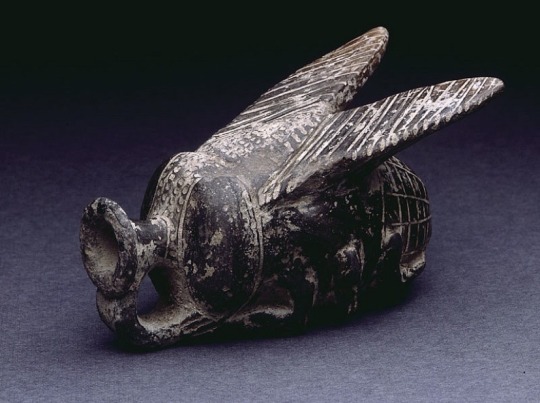
A kooky fly-shaped clay vessel (15th Dynasty)
With its realistic representation of a fly, it includes large eyes, wings, and legs that resemble hands
9K notes
·
View notes
Text
Sekhemre-Wepmaat Intef-Aa
Today I wanted to write about Sekhemre-Wepmaat Intef-Aa, an Egyptian pharaoh who ruled during the 17th dynasty. Sekhemre-Wepmaat Intef-Aa, also called Intef V, was a son of Sekhemre Shedtawy Sobekemsaf II and brother of Nubkheperre Intef. Sekhemre-Wepmaat Intef-Aa ruled the kingdom of Upper Egypt from Thebes. He was buried at Dra Abu el-Naga. Sources:…

View On WordPress
0 notes
Text
— Bracelet of Queen Ahhotep I
This bracelet of Queen Ahhotep I is formed with two semicircles. Gold and lapis-lazuli were used to create its beautiful two-color decoration. The right semicircle depicts Geb, the god of earth, wearing the double crown and seated on the throne. His hands rest on a sign of protection that is on the shoulder and arm of the king kneeling before him.
The other half of the bracelet is engraved with a falcon and a jackal-headed figure representing the Souls of Pe and Nekhen, the mythical ancestors of the rulers of Egypt before unification. Kneeling, their arms are raised in the henu position, typically used in ceremonies and celebrations.

Left: Bracelet of Queen Ahhotep I. Right: Gold Inlaid Bracelet of Queen Ahhotep.
Most of the objects found in the tomb of Queen Ahhotep bear the names of her sons, Kamose and Ahmose, the kings that chased the Hyksos out of the country. The queen played a major role during the war of liberation as testified by the many objects that her sons donated to her grave goods. Some of those gifts were weapons, unusual for a woman’s tomb.
Second Intermediate Period, 17th Dynasty, ca. 1560-1530 BC. Height 3.4 cm, diameter 5.5 cm. From Dra’ Abu el-Naga’, West Thebes. Now in the Egyptian Museum, Cairo. JE 4684
— Beaded Bracelet of Queen Ahhotep
This beaded bracelet of Queen Ahhotep, which is one of a pair, was found along with other jewels inside her sarcophagus. The bracelet is composed of 30 rows of gold beads and semiprecious stones (lapis lazuli, turquoise and carnelian), alternating with each other in a special design to form triangles and squares.
The clasp is made out of two gold sheets that slide within each other to close the bracelet tight. The clasps are engraved with hieroglyphs that can only be read when the two gold plaques are closed together: they form the cartouches of the queen’s son, Ahmose, who founded the 18th Dynasty. His coronation name, Nebpehtyre , is given on one, and his birth name, Ahmose, on the other.
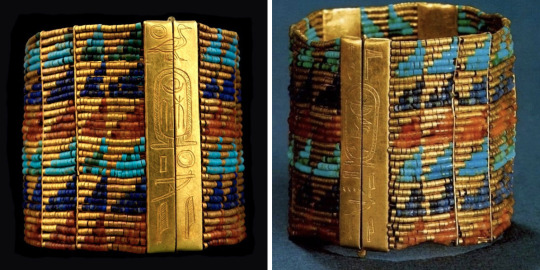
Beaded Bracelet of Queen Ahhotep. Egyptian Museum, Cairo. JE 4685
Most of the objects found in the tomb of Queen Ahhotep bear the names of her sons, Kamose and Ahmose, the kings that chased the Hyksos out of the country. The queen played a major role during the war of liberation as testified by the many objects that her sons donated to her grave goods. Some of those gifts were weapons, unusual for a woman’s tomb.
Second Intermediate Period, 17th Dynasty, ca. 1560-1530 BC. From Dra’ Abu el-Naga’, West Thebes. Excavation by A. Mariette (1859). Now in the Egyptian Museum, Cairo. JE 4685
— Armlet of Queen Ahhotep I
When it was found among the mummy’s hair, this gold armlet of Ahhotep I was thought to be a crown. Because of its diameter, however, it is certain that it was to be worn round the arm for protection. It is inlaid with lapis lazuli and carnelian and decorated with vulture of gold and inlays bearing the names of Ahmose I.
Ahhotep I is the wife of Seqenenre Tao and mother of Ahmose I. Ahhotep II is the queen known from the gilded coffin found at Dra’ Abu el-Naga’ and possibly a wife of Kamose.
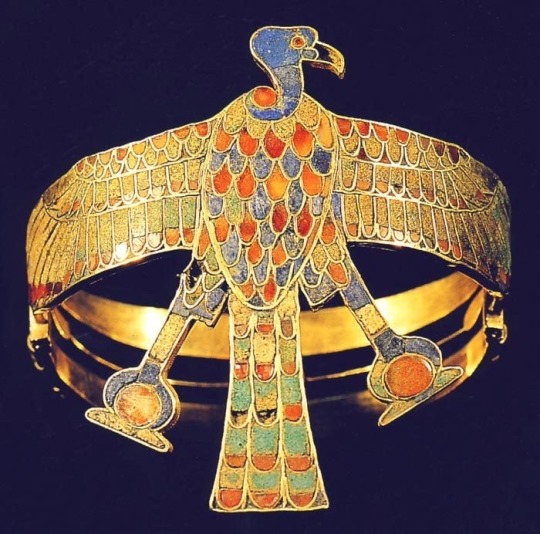
Inlaid Gold Armlet of Queen Ahhotep I
Most of the objects found in the tomb of Queen Ahhotep bear the names of her sons, Kamose and Ahmose, the kings that chased the Hyksos out of the country. The queen played a major role during the war of liberation as testified by the many objects that her sons donated to her grave goods. Some of those gifts were weapons, unusual for a woman’s tomb.
Second Intermediate Period, 17th Dynasty, ca. 1560-1530 BC. Gold, inlaid with lapis lazuli, carnelian and turquoise. From Dra’ Abu el-Naga’, West Thebes. Excavation by A. Mariette (1859). Now in the Egyptian Museum, Cairo. JE 4679
— Gold Inlaid Pectoral of Queen Ahhotep I
This inlaid pectoral of Queen Ahhotep I is in the shape of a shrine. Its base is decorated with wavy lines in reference to the primeval water. It is protected by two falcons. In the center of a boat, King Ahmose I is shown with the gods Re and Amun. The two gods are pouring water on the king in the purification process during the coronation ceremony.
Ahhotep I is the wife of Seqenenre Tao and mother of Ahmose I. Ahhotep II is the queen known from the gilded coffin found at Dra’ Abu el-Naga’ and possibly a wife of Kamose.
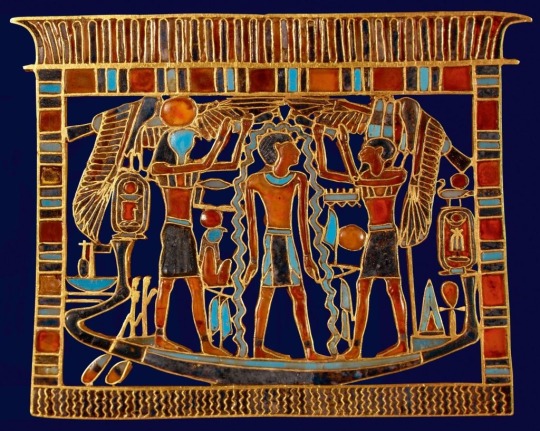
Gold Inlaid Pectoral of Queen Ahhotep I
Most of the objects found in the tomb of Queen Ahhotep bear the names of her sons, Kamose and Ahmose, the kings that chased the Hyksos out of the country. The queen played a major role during the war of liberation as testified by the many objects that her sons donated to her grave goods. Some of those gifts were weapons, unusual for a woman’s tomb.
Second Intermediate Period, 17th Dynasty, ca. 1560-1530 BC. Width 9.2 cm, height 7.2 cm. From Dra’ Abu el-Naga’, West Thebes. Excavation by A. Mariette (1859). Now in the Egyptian Museum, Cairo. JE 4683
— Usekh Collar of Queen Ahhotep I
The Usekh adorned collar of Queen Ahhotep I, with clasp made from two hawk heads, formed by small elements representing baboons, quadrupeds, birds, crosses, bells and geometrical motifs.
Most of the objects found in the tomb of Queen Ahhotep I bear the names of her sons, Kamose and Ahmose, the kings that chased the Hyksos out of the country. The queen played a major role during the war of liberation as testified by the many objects that her sons donated to her grave goods. Some of those gifts were weapons, unusual for a woman’s tomb.
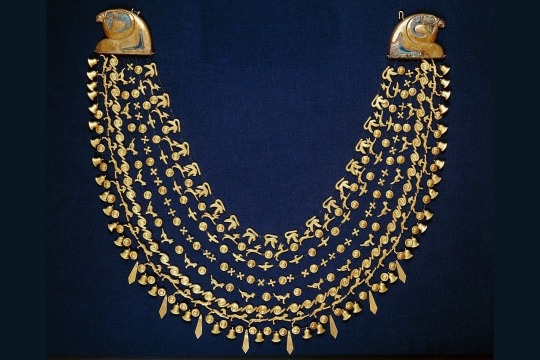
Usekh Collar of Ahhotep I
The Usekh or Wesekh is a personal ornament, a type of broad collar or necklace. It was one of the most common types of Egyptian ornaments. It could be composed of faience beads, flower petals, or gold with semi-precious stone or glass inlays. Like other symbolic pieces of jewelry, Usekh collars were placed among the linen wraps of the mummy to ward off evil from the deceased.
Second Intermediate Period, 17th Dynasty, ca. 1580-1550 BC. Made of gold and semi-precious stones. From the Tomb of Queen Ahhotep, Dra’ Abu el-Naga’, West Thebes. Now in the Egyptian Museum, Cairo. JE 4725a
— Usekh Collar of Tutankhamun
Inside his innermost coffin Tutankhamun was buried with six collars, each with falcon heads at the ends, this amazing Usekh was found draped over the king’s thighs.
A rainbow of colors: This broad collar has 11 main sections made of gold, as well as a counterweight or (mankhet). It is standard collar of tubular beads and has hawks heads at either end. Each section has 8 rows of plaques, made of colored glass. The glass was meant to imitate semi-precious stones: light blue for turquoise, dark blue for lapis lazuli, black for obsidian and red for carnelian. The ninth row represents flower buds.

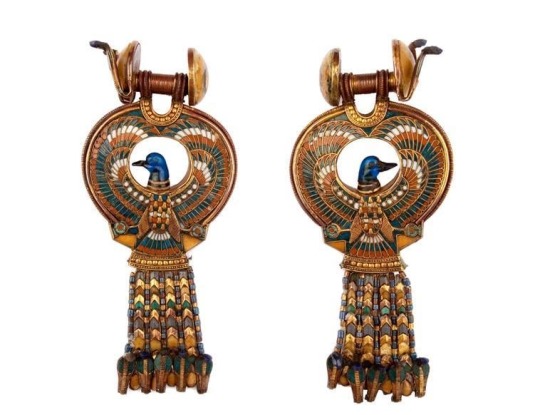
Top: The Usekh Collar of Tutankhamun with Counterweight. Photo: Kenneth Garrett Bottom: Earrings of Tutankhamun with Duck Heads
The Usekh or Wesekh is a personal ornament, a type of broad collar or necklace. It was one of the most common types of Egyptian ornaments. It could be composed of faience beads, flower petals, or gold with semi-precious stone or glass inlays. Like other symbolic pieces of jewelry, Usekh collars were placed among the linen wraps of the mummy to ward off evil from the deceased.
The Usekh or Wesekh is a personal ornament, a type of broad collar or necklace. It was one of the most common types of Egyptian ornaments. It could be composed of faience beads, flower petals, or gold with semi-precious stone or glass inlays. Like other symbolic pieces of jewelry, Usekh collars were placed among the linen wraps of the mummy to ward off evil from the deceased. From the Tomb of Tutankhamun (KV62), Valley of the Kings, West Thebes. Now in the Egyptian Museum, Cairo. JE 61880
— Pectoral with the Throne Name of Tutankhamun
This is a masterpiece of pectoral from the collection of Tutankhamun. It is a pectoral decorated in a complex way: the central part of the pectoral which represents the throne name (or prenomen) of the king, consists in the middle of a large lapis lazuli scarab. Below it is the hieroglyphic sign “neb”, which resembles a basket inlaid with blue glass; above this are the solar and lunar disks made of electrum.
The outer edges of the pectoral are decorated with two cobras that appear to be too large in comparison to the ankh signs, and the wadjet or ‘eyes of Horus’, which are depicted very tightly under the name of the king.
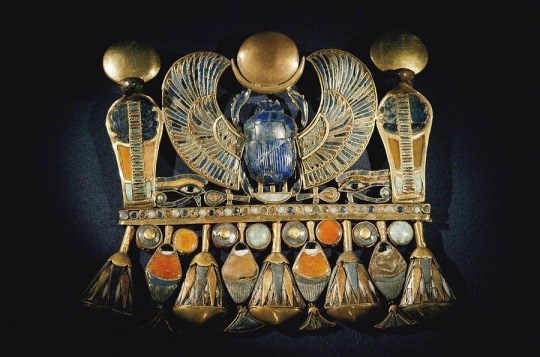
Winged Scarab Pectoral with the Throne Name of Tutankhamun. Photo: Kenneth Garrett
The central scarab is provided with the wings of a falcon. At the bottom of the pectoral is a frieze of lotus flowers interspersed with cornflowers and roundels, all inlaid with lapis lazuli, carnelian, and colored glass.
The lapis lazuli is a very fine-grained rock consisting mainly of lazurite, a mineral responsible for the intense blue color, introduced in Egypt since the fourth millennium BC where it was used for the production of amulets, jewelry and inlays. It then spread to Greece and Crete until it reached the Etruscans and the Romans. In Europe this stone spread from the fifth century AD, where it was used both as a precious stone and as a natural pigment, the ultramarine blue. From the Tomb of Tutankhamun (KV62), Valley of the Kings, West Thebes. Now in the Egyptian Museum, Cairo. JE 61890
— Winged Scarab Pectoral of Tutankhamun
This beautiful winged scarab pectoral illustrates the throne name of King Tutankhamun, “Neb- kheprew-re.” The central element is the scarab “Khepri” made of a fine piece of lapis lazuli, and three strokes of plural “sign in hieroglyphs” below it.
Between the forelegs of the scarab, the risen sun disk “Re” is depicted. It is made of a clear red carnelian set in gold, which represents what, in nature, was the ball of mud and dung containing its eggs that was rolled forward by the beetle. Beneath the plural strokes “sign in hieroglyphs” is a basket shape “Neb” inlaid with turquoise. The wings that are often added to the scarab represent Re, the god of the rising sun. They sweep round to form an almost complete circle, enveloping the royal name and offering it divine protection.

Winged Scarab Pectoral of Tutankhamun
Khepri is the god of creation, rebirth and the rising of the sun. The scarab pushes the sun disc above the horizon and sits on a neb (i.e., basket) sign―signifying its divine nature―supported by three strokes of plural sign, perhaps meaning ‘triple.’ From Tomb of Tutankhamun (KV62), Valley of the Kings, West Thebes. Now in the Egyptian Museum, Cairo. JE 61886
— Winged Scarab Pendant of Tutankhamun
This winged scarab pendant of cloisonné technique is inlaid with semiprecious stones and colored glass. The central element of the pendant is a scarab of Libyan desert glass, grasping on one side a lotus and on the other a papyrus flower, flanked by two uraei, or cobras. A gold frame outlines the main composition and supports pendants of lotus flowers, papyrus, and poppy seed heads.
A slim solar boat rests upon the front feet of the scarab and carries the wadjet or Eye of Horus. It is flanked by two uraei or rearing cobras. The wadjet eye is surmounted by a lunar crescent of gold and a silver disk with images of the gods. Thoth and Ra-Horakhty can be seen crowning the central figure of king Tutankhamun.

Winged Scarab Pendant of King Tutankhamun. Egyptian Museum, Cairo. JE 61884. Photo: Cris Bouroncle
“The center of this intricate pectoral is adorned with a green chalcedony scarab set in the body of a falcon: it symbolizes the sun. The front paws and [tips of the wings] of this composite creature support a celestial boat containing the left eye of Horus ― the emblem of the moon ― crowned by a silver moon disk with a crescent in gold. The pharaoh is depicted in the disk flanked by the moon god Thoth and by the sun god Ra-Horakhty in a protective pose. Flowers and buds of papyrus and lotus plants, the emblems of Upper and Lower Egypt, form the base of the pectoral.”
0 notes
Text





The Barque of Amun Arriving at the West Bank of Thebes - Met Museum Collection
Note: This is a modern copy of an original Inventory Number: 31.6.5 Original Dating: New Kingdom, Dynasty 19, ca. 1295–1213 B.C. Location Information: Original from Egypt, Upper Egypt, Thebes, Dra Abu el-Naga, tomb of Amenmose (TT 19)
Description:
During the Beautiful Festival of the Valley, statues of the deities Amun, Mut, and Khonsu left Karnak temple to journey across the Nile and visit other temples. The procession also passed many private tombs, where people gathered for elaborate banquets.
At the top here, the boat of Amun with ram’s heads at each end carries a shrine that houses the deity’s statue. Though the statue of Amun was not visible, the mere sight of his golden shrine, which was usually in the restricted areas of the temple, must have been a spectacular event for the elated throng of followers. The ship has just moored and is greeted by a statue of the deified king Amenhotep I, which will join the procession. Below a bark with a statue of the deified queen Ahmose Nefertari is being dragged on a sledge.
#The Barque of Amun Arriving at the West Bank of Thebes#new kingdom#ramesside#dynasty 19#upper egypt#thebes#dra abu el-naga#dra abu el naga#tomb of amenmose#met museum#31.6.5#mens clothing#NKRMC
3 notes
·
View notes
Text

Golden Flies of Valor of Queen Ahhotep
Second Intermediate Period, 17th Dynasty, ca. 1560-1530 BC. From Tomb of Ahhotep, Dra’ Abu el-Naga’, Thebes. Now in the Luxor Museum. JE 4694 - CG 52671
Read more
326 notes
·
View notes
Photo
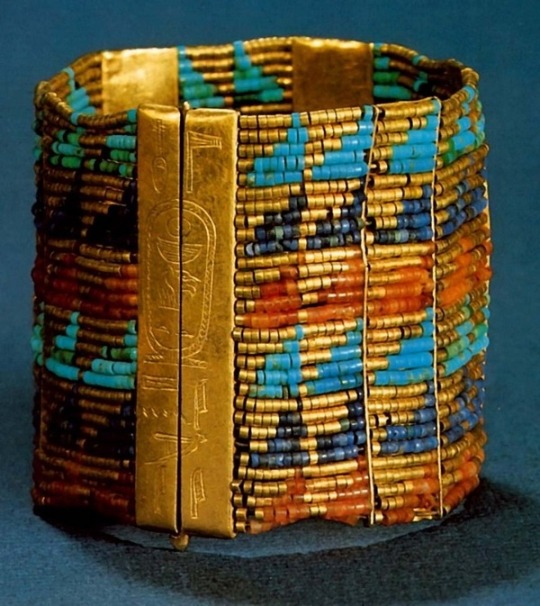
Beaded Bracelet of Queen AhhotepThis beaded bracelet of Queen Ahhotep, which is one of a pair, was found along with other jewels inside her sarcophagus.
Second Intermediate Period, 17th Dynasty, ca. 1560-1530 BC. From Dra’ Abu el-Naga’, West Thebes. Excavation by A. Mariette (1859). Now in the Egyptian Museum, Cairo. JE 4685
The bracelet is composed of 30 rows of gold beads and semiprecious stones (lapis lazuli, turquoise and carnelian), alternating with each other in a special design to form triangles and squares.
The clasp is made out of two gold sheets that slide within each other to close the bracelet tight. The clasps are engraved with hieroglyphs that can only be read when the two gold plaques are closed together: they form the cartouches of the queen’s son, Ahmose, who founded the 18th Dynasty. His coronation name, Nebpehtyre, is given on one, and his birth name, Ahmose, on the other.Most of the objects found in the tomb of Queen Ahhotep bear the names of her sons, Kamose and Ahmose, the kings that chased the Hyksos out of the country.
The queen played a major role during the war of liberation as testified by the many objects that her sons donated to her grave goods. Some of those gifts were weapons, unusual for a woman’s tomb.
18 notes
·
View notes
Photo

Ancient Egyptian hippopotamus figurine, made of faience. Artist unknown; ca. 1650-1550 BCE (17th Dynasty, Second Intermediate Period). Found at the necropolis of Dra Abu el-Naga, Thebes; now in the Louvre. Photo credit: Carole Raddato.
#art#art history#ancient art#Egypt#Ancient Egypt#Egyptian art#17th Dynasty#Second Intermediate Period#animals in art#hippo#hippopotamus#sculpture#figurine#faience#Dra Abu el-Naga#Egyptian Thebes#Louvre#Louvre Museum#Musee du Louvre
107 notes
·
View notes
Link
8 notes
·
View notes
Text

Bronze Axehead from the Tomb at Dra abu el-Naga in Thebes, Egypt dated between 1550-1525 BCE on display in the Ashmolean Museum in Oxford, England
At the start of the 18th Dynasty (about 1550 BCE) , Kind Ahmose extended Egyptian influence in Nubia to the south. Later campaings in the Near East took Egyptian control as far as the Euphrated River in Syria. The axehead is inscribed with the kings name and would have been a common style in the Egyptian armies of this time. Axe heads could be cheap and easy to produce on mass which meant you could arm a larger number of soldiers in a shorter period of time.
Photographs taken by myself 2019
#archaeology#art#military history#ancient#egypt#egyptian#bronze age#ahmolean museum#oxford#barbucomedie
4 notes
·
View notes